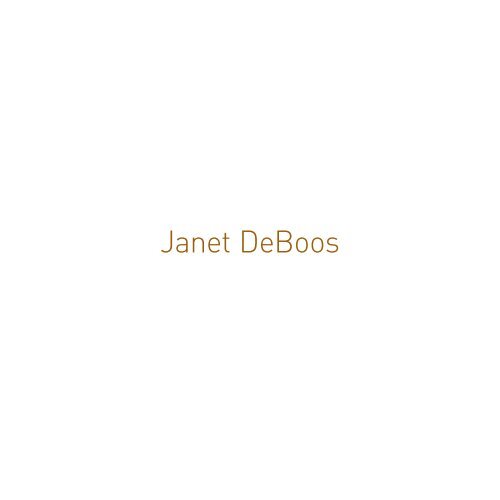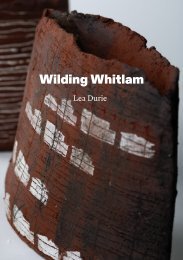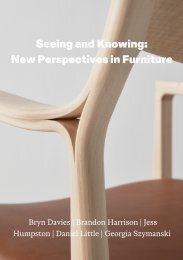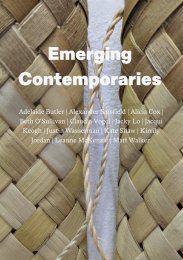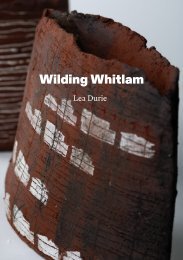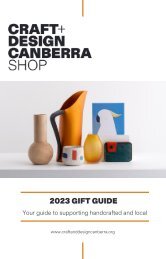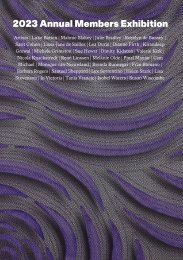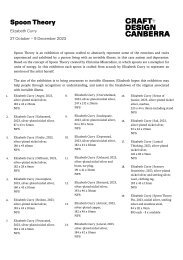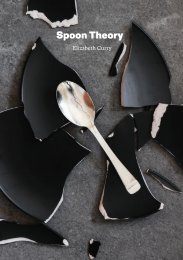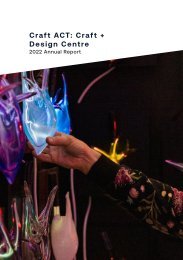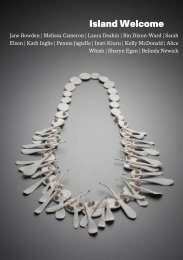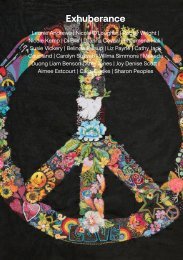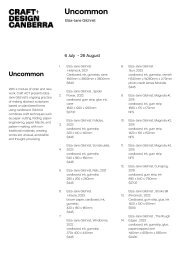Janet DeBoos: A Survey
Curated by Peter Haynes. This exhibition was on display at Craft ACT from 29 May – 11 July 2015.
Curated by Peter Haynes.
This exhibition was on display at Craft ACT from 29 May – 11 July 2015.
You also want an ePaper? Increase the reach of your titles
YUMPU automatically turns print PDFs into web optimized ePapers that Google loves.
<strong>Janet</strong> <strong>DeBoos</strong>
Contents<br />
Foreword................................................................................................................................................................................................................................................................................5<br />
Acknowledgements..............................................................................................................................................................................................................................................7<br />
The poetics of daily life – Jacques Kaufmann (Jk).......................................................................................................................................19<br />
<strong>Janet</strong> <strong>DeBoos</strong>. Functioning Beauty. – Peter Haynes................................................................................................................................21<br />
List of works.................................................................................................................................................................................................................................................................31<br />
<strong>Janet</strong> <strong>DeBoos</strong> – a profile..........................................................................................................................................................................................................................37<br />
Left: Lidded jar, (“Fading” series), 2015<br />
porcellaneous stoneware, Ernabella terra sigillata,<br />
sgraffito, hand drawn laser decals<br />
31.0 x 17.0 (dia)
Foreword<br />
<strong>Janet</strong> <strong>DeBoos</strong>: A <strong>Survey</strong> celebrates the<br />
achievements of one of the most influential<br />
and iconic figures in the Australian craft<br />
movement. The exhibition reflects the wide<br />
reach of <strong>DeBoos</strong>’ aesthetic, intellectual and<br />
technical influences from the 1960s to 2015.<br />
Her life’s work as an international ceramic<br />
artist and educator has been instrumental in<br />
placing Australian ceramics on the world map.<br />
Formerly Head of Ceramics Workshop at the<br />
Australian National University she founded<br />
the Distance Diploma Course giving regional,<br />
remote and international artists opportunities<br />
to study in Canberra, and is the creator of<br />
the distributed studio model for ceramics<br />
education. <strong>DeBoos</strong> has authored three book<br />
on Australian glazes, the first Australian potter<br />
to do so, and has gained global recognition as<br />
an expert in glaze technology.<br />
The following essay by Guest Curator Peter<br />
Haynes reveals the extensive and diverse<br />
career of <strong>Janet</strong> <strong>DeBoos</strong>, and is the first major<br />
publication that surveys her career.<br />
As the nation’s capital, Canberra is a place<br />
of unique sophistication and supports a<br />
highly developed network of educational<br />
and cultural institutions, and artists. Many<br />
Canberra (and region) artists are iconic figures<br />
and masters in their chosen fields. As a key<br />
cultural institution in Canberra, Craft ACT:<br />
Craft and Design Centre works collaboratively<br />
to showcase their work and to highlight<br />
contemporary craft and design that is of<br />
national relevance and significance.<br />
<strong>Janet</strong> <strong>DeBoos</strong>: A <strong>Survey</strong> is a landmark<br />
exhibition and publication and we thank<br />
Peter Haynes for his generosity, insights<br />
and expertise in bringing the exhibition and<br />
publication to life, Craft ACT Curator and<br />
Exhibition Managers Anne Radimin and<br />
Mel George for their commitment to this<br />
project, and to <strong>Janet</strong> <strong>DeBoos</strong> for her life’s<br />
dedication to ceramics in Australia.<br />
Avi Amesbury<br />
CEO and Artist Director<br />
Craft ACT: Craft and Design Centre<br />
Top Left: ‘Harlequin’ domestic ware: teapot, pourer, sugar basin, teacup & saucer, mugs (x 2),<br />
medium sized slab plate (Brindabella Pottery), 1982–2000<br />
porcellaneous stoneware, calcium matte glazes (double dipped), slab plate hump moulded.<br />
(i) cup and saucer 8.5 x 17.5 (overall); (ii) sugar basin 9.5 x 12.0 (overall); (iii) pourer 13.5 x 8.0<br />
(dia); (iv) plate 4.0 x 20.5 x 16.0; (v) teapot 12 .0 x 19.0 (dia); (vi) & (vii) mugs 14.5 x 7.5 (dia) ea.<br />
Bottom Left: Cups (Reflections on use), 1998<br />
glass, porcelain, polystyrene, 18.0 x 55.0 x 12.0<br />
Photography: Rob Little Digital Images<br />
<strong>Janet</strong> <strong>DeBoos</strong> 5
Large vase, 2001<br />
Glazed porcelain<br />
29.0 x 30.0 x 30.0<br />
Collection: National Gallery of<br />
Australia, Canberra, Purchased 2011<br />
Image courtesy of National Gallery<br />
of Australia, Canberra
ACKNOWLEDGEMENTS<br />
Craft ACT: Craft and Design Centre sincerely thanks<br />
Peter Haynes for his dedication to the exhibition<br />
<strong>Janet</strong> <strong>DeBoos</strong>: A <strong>Survey</strong>. Peter was first invited<br />
to curate the exhibition in 2013 and his ongoing<br />
commitment to chronicling the life’s work of <strong>Janet</strong><br />
<strong>DeBoos</strong> has been outstanding. The many hours<br />
he has given to the exhibition’s development and<br />
the publication is testament to his leadership and<br />
passion for Australian ceramics.<br />
I warmly thank <strong>Janet</strong> <strong>DeBoos</strong> who saw fit to entrust<br />
Craft ACT: Craft and Design Centre with a survey<br />
exhibition of her life’s work. It has been an honour<br />
to be part of her journey.<br />
We thank Craft ACT Curator and Exhibition<br />
Managers Anne Radimin and Mel George, and intern<br />
Erin Gazzard, who assisted the Guest Curator.<br />
We thank those who kindly loaned works from<br />
their private collections, including:<br />
Liz Dennis, Rock pool bowl, (Change of scenery<br />
series), 1991; Jeroen Bechtold and Jos Doop,<br />
Yixing teapot, 1996; Anne Morton, “Solitary<br />
pleasures”, 2001; Tony Dagg, “Pour” (“Hold, pour,<br />
separate” series) 2001; Greg Daly, “Vase”, 2002;<br />
Shaanxi Fuping Pottery Art Village Co. Ltd, Large<br />
Bottles, 2006; China Art Academy, Celadon pourer<br />
and lidded jar, 2011.<br />
Craft ACT: ACT Craft and Design Centre extends<br />
its gratitude to the National Gallery of Australia<br />
for their support, and for loaning Large vase,<br />
2001 and Qing Tree Vase, 2010.<br />
Avi Amesbury, CEO and Artist Director<br />
Craft ACT: Craft and Design Centre<br />
I would like to thank Peter Haynes for his clarity and<br />
insight, and for his thoughtful documentation of my<br />
life and career. It has enabled me to physically see<br />
my work as a continuum for the first time.<br />
I would also like to give thanks to<br />
> the team at Craft ACT: Craft and Design Centre,<br />
CEO/Artistic Director Avi Amesbury and Curator<br />
and Exhibition Managers Anne Radimin and Mel<br />
George, for their gracious and constant work on<br />
this project;<br />
> Sabbia Gallery and Narek Gallery and the many<br />
curators and galleries who have shown my work<br />
and to collectors and collecting institutions who<br />
have acquired it;<br />
> to the Australian National University and the<br />
NSW TAFE sector where I spent many happy<br />
years both as a student and a teacher;<br />
> to Shandong Zibo Huaguang Bone China, The<br />
China Art Academy in Hangzhou; to Ernabella<br />
(Pukatja) Art Centre and especially to all my<br />
teachers, fellow artists, writers and colleagues<br />
from whom I have learnt so much, and with whom<br />
I have had such fun on this marvellous frolic.<br />
A particular thank you to the many friends and<br />
colleagues who loaned work for this exhibition,<br />
and have continually supported me.<br />
I would also like to specially thank Michael Wignall<br />
and Mary Wignall, for their continued support<br />
of my practice and Peter Rushforth, who in 1969<br />
said ‘what are you doing next year? Why don’t you<br />
come and study ceramics full time?’<br />
This exhibition is dedicated to you three.<br />
<strong>Janet</strong> <strong>DeBoos</strong><br />
<strong>Janet</strong> <strong>DeBoos</strong> 7
The poetics of daily life.<br />
In a world dominated by spectacle and external<br />
appearance; in a world of blurred boundaries<br />
and rapid change; <strong>Janet</strong> <strong>DeBoos</strong> proposes a<br />
determined counter-posture of silent, physical<br />
rapport with the object. Set within the temporal<br />
limits of the act of making, and of domestic<br />
use, her activity finds its source in an intimate<br />
exchange, in the instant of interaction with<br />
her materials; with her own internal thoughts<br />
and imagination; and with those of “the other”,<br />
those who enter into the artist’s creative space<br />
through engagement with her physical objects.<br />
This simple stance allows her to act with<br />
certainty in an uncertain world. <strong>Janet</strong> <strong>DeBoos</strong><br />
seeks a world of sensations that draws on<br />
reverie, on presence, on real encounters with<br />
the act of creation.<br />
For <strong>Janet</strong> <strong>DeBoos</strong> the poetics of daily living<br />
cannot be expressed in ostentatious displays<br />
of craftsmanship. She is of course well aware<br />
of the importance of the hand and knowledge<br />
of her chosen material. She is also an active<br />
participant in the national and international<br />
discourse and debates around the search for<br />
a balance between technique and concept.<br />
The question of skill, of knowledge, is for her<br />
filtered through meaning and all that that<br />
embraces: sensations, reason, value, direction,<br />
conscience.<br />
<strong>Janet</strong> <strong>DeBoos</strong>’s journey is a witness to the<br />
power of personal curiosity, a characteristic<br />
that provides a powerful engine, allowing<br />
her to plough diverse fields: materials, tools,<br />
cultures.<br />
Her art expresses a poetic rapport with the<br />
world that offers a daily soul-to-soul contact<br />
via the functional object.<br />
As on a journey: leaving home and opening<br />
oneself up to the world.<br />
Jacques Kaufmann (Jk)<br />
Hangzhou<br />
Jacques Kaufmann is a ceramist, academic<br />
and is the current President of the International<br />
Academy of Ceramics Council.<br />
Translated and Edited by Peter Haynes<br />
Left: Domestic ware, ca 2003<br />
Australian porcelain, clear glaze<br />
(i) lge pourer 26.0 x 9.0 (dia); (ii) med. pourer 16.0 x 7.5 x 5.5;<br />
(iii) sm. pourer 10.0 x 7.0 (dia); (iv) lidde. bottle 20.0 x 5.0 x 7.5<br />
(dia); (v) teapot 13.5 x 11.0 (dia); (vi) handled cup 8.5 x 9.0 (dia);<br />
(vii) lge mug 12. 0 x 7.5 (dia); (viii) med. mug 9.0 x 8.0 (dia);<br />
(ix) sm. handled mug 8.0 x 6.0 (dia); (x)sm. mug 4.5 x 5.5 (dia)<br />
<strong>Janet</strong> <strong>DeBoos</strong> 9
<strong>Janet</strong> <strong>DeBoos</strong>.<br />
Functioning Beauty.<br />
…one of the real joys of ceramics is...that<br />
exhilarating breath of difference, the sense<br />
of ambiguous and constant reinvention that<br />
is a marker for art (1). Edmund de Waal.<br />
<strong>Janet</strong> <strong>DeBoos</strong>’s art is conceptually complex,<br />
referentially rich and aesthetically beautiful.<br />
It is the result of an incisive intelligence that<br />
understands the importance of the history of<br />
her medium (clay) and the role of the vessel<br />
throughout that history. The domestic aspect<br />
of clay’s history as manifested through the<br />
vessel form in numerous guises is substantial<br />
and is indeed integral to not only the history<br />
of ceramics but to an understanding of that<br />
history. The domestic incorporates function<br />
and <strong>DeBoos</strong>’s engagement with the function<br />
of the functional is the sine qua non of her<br />
practice. Her engagement is not simple,<br />
although it may be direct. She is aware that<br />
the vessel can be more than container and<br />
that its metaphorical associations (such as<br />
container of ideas, of the spirit, the soul) are<br />
active constituents of each vessel made.<br />
But paramount in her thinking about making<br />
are the reverberations that are endemic to<br />
the functioning vessel.<br />
She writes:<br />
In the general perception of ceramic works<br />
there exists a gap between those pieces that<br />
are functional and those that are not, whatever<br />
the intent of the artist might have been. The<br />
gap I prefer to see as a space in which to<br />
work – a space from which I can have access<br />
to both that rich history of functional pottery<br />
and the more conceptual concerns of purely<br />
sculptural ceramics. The longer I work with<br />
functional form the more I realise its potential<br />
as a vehicle for artistic expression. Every jug<br />
carries with it the whole history of jugs and<br />
their usage, every teapot relates to the facts<br />
of human relationships and daily life. As we<br />
move away from these functional realities,<br />
there is an increase in status for the work<br />
in that it is more readily perceived as being<br />
artistic in intent. What we have to ask is what<br />
is the corresponding loss. This question is my<br />
concern and I seek answers to it by working<br />
with the same forms in both functional and<br />
non-functional ways. The resonance that is<br />
established between them will hopefully cause<br />
the viewing public to ask the same question.” (2)<br />
Left: Qing teaset, 2003/4<br />
Huaguang Zibo bone china, overglaze decals<br />
teapot 13.0 x 13.0(dia); cup (x 4)7.0 x 7.0 (dia)<br />
<strong>Janet</strong> <strong>DeBoos</strong> 11
Although written some twenty years ago, the<br />
preceding quote points to a number of issues<br />
that remains relevant in <strong>DeBoos</strong>’s practice.<br />
I have stated that her art and her approach<br />
to it, is complex. The intellectualising of<br />
making and the processes of making imbues<br />
a conceptual edge into the object being made.<br />
<strong>DeBoos</strong> believes that any meaning held by an<br />
object is intimately connected to its (manner<br />
of) making. Art making is not for her just an<br />
expressive human utterance but equally an<br />
activity of the mind that comes from a place<br />
wider than the individual human. There are<br />
social and cultural imbrications that inform<br />
human actions and that give rise to meaning<br />
and significance. These <strong>DeBoos</strong> sees as being<br />
integrated into the procedural technologies<br />
that go into the making of the object.<br />
The object or more especially the functional<br />
object is endowed with a form that (ostensibly)<br />
fits its function. The functional object and its<br />
concomitant physical engagement with the<br />
user involve touch on an ongoing basis and<br />
thus we come to know the object as a physical<br />
thing, not necessarily as a carrier of ideas.<br />
<strong>DeBoos</strong>’s oeuvre interrogates this through a<br />
range of conceptual and aesthetic strategies<br />
that announce and embrace their origins as<br />
much in social and cultural realms and in<br />
the history of ceramics and in contemporary<br />
ceramic practice as in her own ways of making.<br />
The conscious contiguity of concept, its<br />
development and process (“the joy of making”),<br />
filtered through the artist’s critically refined<br />
intellectual and aesthetic modes has resulted<br />
in a unique stylistic language exemplified in a<br />
prodigious body of work that holds universal<br />
significance. The following discussions of a<br />
number of works aim at exemplifying and<br />
expanding some of the preceding as it is<br />
made concrete through the artist’s objects.<br />
While being essentially chronological the text<br />
will move through the artist’s work, crossreferencing<br />
and ambulatory in its approach (3).<br />
<strong>DeBoos</strong> came to ceramics somewhat<br />
circuitously through evening classes initially<br />
at St George Technical College in Sydney,<br />
then to East Sydney Technical College (the<br />
“National Art School”) with Peter Rushforth<br />
and thence to a full-time Ceramics Certificate<br />
at the same institution from 1970 to 1971<br />
following completion of her Science degree<br />
at the University of Sydney. Making however<br />
was something with which she was already<br />
involved. Her mother taught her sewing when<br />
she was young and baking was an important<br />
part of her domestic skills (4). The interest in<br />
food and its accoutrements remains and is<br />
obviously evident in her ceramic output. The<br />
earliest works in the exhibition (see Image 1)<br />
are from about 1963. One is a pinch pot the<br />
other a handled mug. Both are terracotta and<br />
covered in honey glazes. The forms are sure<br />
and combined with the well-attuned surface<br />
decoration speak of an early understanding<br />
of the need for the coalescence of form and<br />
decoration to achieve successful resolution.<br />
The lidded stoneware jar (Image 1) from c1969<br />
is more assured and attests to the value of her<br />
night classes. These works already establish<br />
an aesthetic of the simple and of function.<br />
12 CraftACT: Craft and Design Centre
Hybrid Qing garniture, 2010 (original)/2015<br />
porcellaneous stoneware, Ernabella terra sigillata, underglaze colour, sgraffito decoration, stock decals<br />
(i) 18.0 x 10.0 x 12.0; (ii) 17.5 x 9.0 x 11.5; (iii) 17.0 x 9.0 x 11.0; (iv) 18.0 x 9.0 x 11.0; (v) 17.5 x 8.0 x 11.0<br />
Examples of student work (see Image 2) reveal<br />
<strong>DeBoos</strong>’s capitalising on the expertise of the<br />
East Sydney Technical College staff. Apart from<br />
the legendary Peter Rushforth other teachers<br />
included Col Levy, Peter Travis, Bernard Sahm<br />
and Joan Grounds. The catholic nature of their<br />
combined practices offered and provided a<br />
heady place from which to launch a career in<br />
ceramics, and while <strong>DeBoos</strong> went on to study<br />
for a Diploma in Education her future path<br />
was set. Alan Peascod, with whom <strong>DeBoos</strong><br />
taught at the Canberra Technical College in the<br />
early ‘seventies, was another whose abilities,<br />
particularly with throwing and the handling<br />
of clay generally, have a lasting impact on the<br />
artist. While “influence” is difficult to define<br />
it should be seen in <strong>DeBoos</strong>’s case as an<br />
appreciation of the stylistic characteristics, the<br />
approach to practice and the means of making,<br />
of the nominated individuals. It does not in any<br />
way signify a desire to emulate but rather a<br />
desire to understand why each artist does what<br />
he or she does to achieve his or her formal and<br />
aesthetic ends. The logistics of each artist’s<br />
ways of making within a unique stylistic and<br />
formal vocabulary rides tandem with her<br />
own and thus provides reinforcement of her<br />
chosen path.<br />
In 1982 <strong>DeBoos</strong> and her husband established<br />
the Brindabella Pottery at Wee Jasper outside<br />
Canberra. This enterprise continued until<br />
1998 when <strong>DeBoos</strong> accepted the position as<br />
Head of Ceramics at the ANU School of Art.<br />
Brindabella Pottery was concerned with the<br />
production of domestic ware.<br />
I was making domestic ware, which was always<br />
my real love…as well as dry-glazed decorative<br />
pots which were based on functional forms, so<br />
‘like teapots’ or ‘like jugs’. (5).<br />
<strong>Janet</strong> <strong>DeBoos</strong> 13
Hybrid Banksia tray (“Hybridising” series), 2015<br />
porcellaneous stoneware, Ernabella terra sigillata, black underglaze, sgraffito decoration,<br />
stock and hand drawn overglaze decals, 5.5 x 33.0 (dia)<br />
Examples of Brindabella Pottery’s output<br />
(Images 6, 7 and 8) reveal a consummate<br />
understanding of form as well as seamlessly<br />
appropriate surface decoration. <strong>DeBoos</strong> has<br />
stated that her major formal impulse was<br />
always more concerned with the shape of a<br />
pot than with its decoration (6). The evidence<br />
as evinced in the Brindabella pots says that<br />
there is an innate realisation of the need for<br />
a happy elision of the two. The “Harlequin”<br />
domestic ware, as well as the tenmoku pieces,<br />
is beautifully resolved. They are eloquent<br />
iterations of the artist’s grasp of the underlying<br />
liturgical incursion into the everyday that is<br />
embodied in the utensils of quotidian life. The<br />
unstated way these utensils are used – the<br />
maker does not know what purpose others<br />
will see in them – is a positive reinforcement<br />
of <strong>DeBoos</strong>’s interrogative stance. She does not<br />
dictate. She opens possibilities that operate on<br />
multiple levels. The “rightness” of the artist’s<br />
forms in an aesthetic sense will re-emerge in<br />
quietly altered morphologies throughout her<br />
career. The assertion of a hegemony in which<br />
thinking form into existence is paramount will<br />
remain a constant in <strong>DeBoos</strong>’s oeuvre.<br />
The Brindabella Pottery closed in 1998<br />
when <strong>DeBoos</strong> became Head of the Ceramics<br />
Workshop at the Australian National University<br />
(ANU) School of Art. The extended period<br />
of producing multiple editions of a range<br />
of domestic wares imbued in the artist an<br />
ongoing respect for the functional as well<br />
as a deep understanding and respect for<br />
the value of repetition as a mode of making.<br />
14 CraftACT: Craft and Design Centre
Repetition implies the re-making of the same<br />
form(s) over and over. Associations of dullness<br />
and boredom arise for most but not for<br />
<strong>DeBoos</strong>. The continuing investigation through<br />
making of the same cups, mugs, teapots,<br />
etcetera provides opportunities for constant<br />
re‐examination of both form and function; for<br />
constant renegotiations with previously held<br />
positions; and for determining the changing<br />
relationships of use to meaning. Her notion of<br />
repetition embraces change within sameness.<br />
A contradiction perhaps but its imposition has<br />
resulted in a prodigiously fertile and varied<br />
output throughout her oeuvre. Repetition offers<br />
the space/place for contemplation, the latter<br />
of course a given in <strong>DeBoos</strong>’s conceptual and<br />
aesthetic approach to making art.<br />
The experience of producing multiples has<br />
many examples a number of which are<br />
included in the present exhibition. “Reflections<br />
on use” (Image 18) from 1998 is a clever<br />
visual comment. It consists of a set of five<br />
porcelain cups sitting on a glass shelf, the<br />
latter supported by five inverted polystyrene<br />
mugs. Its punning title is given subverted life<br />
in the insertion of the polystyrene mugs as the<br />
plastic “reflection” of the porcelain cups that<br />
sit, carefully lined up, above them. The cups<br />
are beautiful and useful, the mugs useful.<br />
The presentation is a question to viewers. The<br />
answer is for the viewers to find.<br />
<strong>DeBoos</strong> also made “exhibition pieces” parallel<br />
with her work at the Brindabella Pottery.<br />
These were generally further explorations<br />
into the domestic role of ceramics and from<br />
about 1995 in porcelain, undecorated aside<br />
from subtly introduced gestural flourishes<br />
embedded into the form. I say “undecorated”<br />
because decoration as such was something<br />
the artist eschewed in her earlier work and<br />
indeed continued to “avoid” until the late 1990s.<br />
However I believe that the manipulations of<br />
form and surface instilled so quietly into her<br />
work are indeed decoration and should be seen<br />
as incipient exemplars of the more robust and<br />
colourful decorative surfaces of the work from<br />
the late 1990s.<br />
“Teaset (After Kanazawa)” from 1999 (Image<br />
19) is a delightful piece. The title refers to the<br />
city of Kanazawa in Japan, noteworthy for<br />
its seventeenth-century castle and garden.<br />
It consists of a tray in which sit a teapot, jug,<br />
basin and mug. The trademark white porcelain<br />
is broken by colourful patterns of flowers, dots,<br />
stripes, in red, orange, yellow, lime green and<br />
blue. The overall effect is bright and cheery.<br />
The forms, particularly the teapot, continue to<br />
be enlivened by what is by now the signature<br />
sculptural indentation, that purposeful<br />
distortion of formal perfection that is so<br />
entrancing. The combination of the utensils<br />
sitting within the tray is a highly attractive<br />
mannerism that is used by the artist to great<br />
effect. It is a metaphor for the comforts of the<br />
domestic environment, a comment on the value<br />
of (here) singular meditation and the solace of<br />
time spent alone. The tray as container speaks<br />
of the liturgy of domestic life.<br />
A further declaration of the attraction of<br />
the domestic is seen in “Six possibilities for<br />
Monday morning” (Image 20) from 1999. In<br />
a wooden shadow box six cups are placed in<br />
<strong>Janet</strong> <strong>DeBoos</strong> 15
separate compartments. Each is singularly<br />
decorated, all united by their function. There<br />
is inherent in the means of display a reference<br />
to the notion of “a collection”, a sort of set<br />
of objects holding special connection for<br />
the owner. There is wry comment at play<br />
here (a device often present in <strong>DeBoos</strong>’s art)<br />
that questions ideas of preciousness. The<br />
artist underscores this by the fact that the<br />
“possibilities” mentioned in the title refer to<br />
the very ordinary role of selecting which mug<br />
or cup will be used for this morning’s tea or<br />
coffee. <strong>DeBoos</strong>’s interrogative stance throws<br />
up a range of issues from function, display,<br />
collecting, the domestic and its rituals (the<br />
latter another instance of the role of repetition).<br />
The notion of “sets” is important to <strong>DeBoos</strong><br />
and has provided impetus for some of her most<br />
convincing works. “Set Theory”, the nominal<br />
title the artist uses to cover a rather broad<br />
range of works consisting of multiple units,<br />
was a concept familiar to her through her early<br />
education in mathematics (and science). A “set”<br />
was a discrete piece consisting of a number<br />
of like units. The maths is foreign to me but<br />
in terms of ceramics we are all familiar with,<br />
for example, dinner sets, coffee sets, tea sets.<br />
They are sets because they match. <strong>DeBoos</strong><br />
proposes that sets do not have to comprise<br />
a number of like units. Their composition is<br />
determined by the maker not by accepted<br />
practice or historical exemplars. They are a<br />
“set” because they share common use. <strong>DeBoos</strong><br />
believes a cup is a cup is a cup, that is that<br />
function provides familial relationship even if<br />
form, decoration, cultural origin, or whatever<br />
do not. That the members of the set were<br />
made (or selected) by the artist is arguably the<br />
most relevant element in determining familial<br />
association. I like the theoretical quirkiness<br />
of her proposition and that it arises from her<br />
thinking about function, non-function and their<br />
interactions, done during the actual processes<br />
of making, during the repetitive actions of the<br />
hands. I like even more the ceramic expression<br />
of this.<br />
Although not nominated as a “set” the<br />
impressive “Large vase” (Image 22) of 2001<br />
in the collection of the National Gallery of<br />
Australia, serves to show that for <strong>DeBoos</strong><br />
defining stylistic trends within her practice<br />
highlights the fluidity of such definitions. The<br />
artist’s consummate understanding of her<br />
material (Australian porcelain) and its surface<br />
decoration (glaze) is beautifully exposed. Nine<br />
bottles set within an elegant tray constitute<br />
the “vase” of the title. Its multiple parts may<br />
reference Dutch tulip vases of the seventeenthand<br />
eighteenth-centuries, but their<br />
combination certainly expresses <strong>DeBoos</strong>’s<br />
unique and very contemporary Australian<br />
aesthetic. The bottles, apart from size, are<br />
almost identical. The different heights impart<br />
a rhythmical flow around and through the<br />
piece that is nicely contained and controlled by<br />
the circular walls of the tray. The union of the<br />
verticality of the bottles with the horizontality<br />
and circularity of the tray imbues “Large vase”<br />
with a lively sculptural tension and physical<br />
lightness, the latter reinforced by the fineness<br />
16 CraftACT: Craft and Design Centre
of the porcelain body so exquisitely controlled<br />
by the artist.<br />
<strong>DeBoos</strong>’s exploration of issues around<br />
function, the domestic and the handmade<br />
may be seen to have connections with a<br />
nostalgic Romantic vision of the artist but it<br />
has resulted in a number of other questioning<br />
narratives that have continuing reverberations<br />
in her work. One of these has been alluded<br />
to previously and it concerns the relationship<br />
between the appearance of the handmade<br />
object and that of the industrially produced<br />
object. In postmodern jargon the industrial<br />
product could be said to be a simulacrum of<br />
the handmade object. <strong>DeBoos</strong> posited the<br />
thesis that there were no real qualitative<br />
differences between the so-called crafted<br />
object and that produced in the factory. This<br />
was tested in 2002/03 when an Italian company<br />
Paolo C Ceramiche purchased some of her<br />
work as prototypes for industrial production.<br />
The results as exemplified here (Images 26,<br />
27 and 28) have a precise definition that moves<br />
them slightly from her own objects but the<br />
presence of the artist’s hand (albeit a number<br />
of stages removed) is vehemently there and the<br />
strength of her stylistic language is not lost. I<br />
believe that this “testing of the design waters”<br />
is another instance of the making through<br />
thinking (or vice versa) approach<br />
that is essential to any understanding of<br />
<strong>DeBoos</strong>’s art.<br />
Within the exhibition it is instructive to view the<br />
above in relation to a selection of the artist’s<br />
domestic ware from ca. 2003 (Image 29).<br />
While taxonomic similarities are overt there is<br />
nevertheless the infusion of a morphological<br />
insouciance in the handmade that is at once<br />
distinctive and eloquent. The signature<br />
sculpturally indented slashes into the bodies<br />
of the various objects (pourers, bottles, cups,<br />
basins, mugs) although present in both the<br />
industrial and the handmade, are more actively<br />
present in the latter. By this I mean that they<br />
are both of the body of the object and on the<br />
body simultaneously. They are at once form<br />
and decoration.<br />
A further and more long lasting relationship<br />
with industry/design than that with Italy is<br />
<strong>DeBoos</strong>’s work in China. An invitation in 2003<br />
to work in Zibo in Shandong Province has<br />
proved to be of especial significance. The<br />
professional results from the initial period<br />
of work have continuing repercussions<br />
for <strong>DeBoos</strong>. Her wonderfully interrogative<br />
approach to everything she does has been<br />
put to no better test than in her Chinese<br />
investigations. Arguably, apart from the plastic<br />
results, the determination that while she may<br />
now be considered (at least part of the time)<br />
as a designer, that the most intuitive designers<br />
must also be makers, has reaped a multiplicity<br />
of benefits. The “Qing teaset” of 2003/04<br />
(Image 31) is a very pleasing coalescence<br />
of history, design and a maker’s sensibility,<br />
produced in an industrial setting. While the<br />
forms are vigorously decorated the nuanced<br />
morphological shadows of resemblance are<br />
especially moot and one need only look at<br />
the gentle curve of the teapot’s spout and its<br />
<strong>Janet</strong> <strong>DeBoos</strong> 17
Teaset After Kanazawa, 1999 (original)/2015<br />
porcelain teapot 13.0 x 12.0 (dia); cup 8.0 x 7.0 (dia); jug 10.5 x 5.5 (dia); basin 7.0 x 7.0 (dia); tray 4.5 x 31.5 (dia)<br />
repetition in the curve of the cup to appreciate<br />
the refined approach to design that the maker<br />
has brought to this piece. As always in <strong>DeBoos</strong>’s<br />
complex mind, this work’s overt decorative<br />
Chinese-ness is placed against the artist’s<br />
very individual take on equally Chinese-ish<br />
forms. Aesthetic tension makes a comfortable<br />
partner in this culturally celebratory piece. The<br />
artist’s continuing professional relationship<br />
with Chinese factories has produced some<br />
captivating works. These address those<br />
dichotomous concerns that give her works<br />
a particular aesthetic tension. Industrially<br />
produced, based on her designs and prototypes,<br />
they still hold the lure of the handmade, and<br />
are made with the infusion of that lure in mind.<br />
A range of examples illustrates how simplicity<br />
of form aligned with assigned yet unstated<br />
purpose produces beautiful results (see for<br />
example, Images 44, 47, 52 and 53).<br />
I referred above to the artist’s embracing<br />
of the (originally) mathematical notion<br />
of Set Theory. From about 2003 <strong>DeBoos</strong><br />
begins titling works with that nomenclature.<br />
These are as various and rambling as the<br />
individual units that comprise them. In their<br />
multifarious manifestations they are visually<br />
and conceptually compelling and intellectually<br />
demanding. Their variety, both within a single<br />
work and across the “series” (one needs to<br />
be careful of limitation in terms of definition),<br />
18 CraftACT: Craft and Design Centre
imbues aesthetic excitement and does<br />
not allow the viewers to be simply passive<br />
observers. There is a lot happening in these<br />
works and “Set Theory” 2004/2010 (Image 34)<br />
is a powerful demonstration of this. Here all<br />
the questions that involve <strong>DeBoos</strong>’s creative<br />
and intellectual energies are on display.<br />
Handmade, bone china, porcelain, decals,<br />
manufactured pieces, are drawn together in<br />
an amalgamation whose overall appearance<br />
is available for change by whoever chooses.<br />
The artist’s characteristic forms are allied<br />
to commercial products by the decorative<br />
additions of elements of the “Winter Rose”<br />
pattern. This is chiefly associated with chintz<br />
textile designs and its “Englishness” thus<br />
becomes another layer into the already<br />
complex cultural imbrications of <strong>DeBoos</strong>’s art.<br />
Viewers are required (not “asked”) to travel<br />
through this work (as indeed they are with all<br />
the artist’s work) and to question not only the<br />
artist’s intent but the questions that inform<br />
that intent and their own reactions to those<br />
questions and their visual manifestations.<br />
The diversity within the “limitations” of “Set<br />
Theory” is clearly averred in another piece<br />
from 2004, also titled “Set Theory” (Image 35).<br />
Three elements (tray, mug, cup) intimate innate<br />
possibilities for variation. While the previous<br />
work has multiple units, this piece’s three<br />
units insinuate if not the same at least similar<br />
possibilities for taxonomic re-formation.<br />
Ever peripatetic in 2008 <strong>DeBoos</strong> began<br />
what would be another ongoing working<br />
relationship, this time with the Ernabella<br />
Arts Centre in remote South Australia. Her<br />
role was essentially an educative one but<br />
her experiences there resonate with her own<br />
work and, like the Chinese collaborations,<br />
open new aesthetic opportunities and new<br />
questions about ceramics and its role in<br />
different cultures and how her experiences<br />
can be best translated into her own oeuvre.<br />
The artist’s strategies in doing this have their<br />
origins in coming to terms with the importance<br />
of decoration in much Chinese ceramics. In an<br />
unpublished text written earlier this year she<br />
wrote of a discussion with her Chinese mentor<br />
about the use of decoration, or in her case, the<br />
non-use of decoration:<br />
Decoration was a foreign language to me…<br />
and I had to ‘think about it” So I did, and<br />
tentatively started trying brushwork, decal<br />
application and sgraffito drawing through fine<br />
clay slips. All of these things I had taught –<br />
and in the way that we do as teachers, I had<br />
made demonstration examples – some of<br />
which I really enjoyed. So starting with this<br />
more familiar work, decoration crept into<br />
my vocabulary…Once started, I found that<br />
I could not stop, and decoration became a<br />
way to try and make sense of “Chineseness”<br />
and “Australianness” and what was their<br />
relationship in my life.”<br />
This aesthetic epiphany had major<br />
repercussions on <strong>DeBoos</strong>’s art. From 2008<br />
a remarkable series of works addressing<br />
Chinese ceramic traditions, Indigenous<br />
Australia, the Australian environment and<br />
her own understanding of these in relation<br />
to her incisive intellectual way of dealing<br />
<strong>Janet</strong> <strong>DeBoos</strong> 19
with art and life, has been the outcome. A<br />
set of bottles from 2008 (Image 45) sees her<br />
addressing her “Australianness”. These are<br />
made with Australian porcelain and Ernabella<br />
terra sigillata, materials absolutely of the<br />
land. The bottle form is repeated four times<br />
with elongated necks, one without a neck.<br />
The body of three are black; the brown/ochre<br />
necks enlivened with thin vertical stripes<br />
that emphasis the elegant narrowness of the<br />
necks. The black bodies sport examples of<br />
native Australian flora and other decorative<br />
motifs associated with Indigenous ceremony.<br />
The insertion of the latter is both quiet<br />
acknowledgement of Indigenous culture but<br />
also a statement about the ritual associations<br />
of ceramics that has informed <strong>DeBoos</strong>’s art for<br />
decades. The black bottles act as integrated<br />
background to the smaller ochre bottles. The<br />
neckless example is joyously covered with<br />
sgraffito decoration with similar motifs to that<br />
of the black bottles. The limited palette with<br />
its striking contrasts is beautifully effective.<br />
There is a lovely rhythm imbued in this<br />
grouping reinforced by the gentle spatial flow<br />
surrounding the bottles. The celebration of<br />
something Australian is indeed present.<br />
The elision of Chinese and Australian motifs is<br />
a natural step in <strong>DeBoos</strong>’s explorations and is<br />
powerfully exemplified in a number of works<br />
in the exhibition. “Hybrid Qing garniture”, 2010<br />
(Image 49) consists of five open-mouthed jars<br />
dispersed in a strict linear fashion. Colourful<br />
Chinese floral motifs play with more graphic<br />
Australian flora, the sharp serrations of the<br />
Banksia leaves in marked contrast to the lush<br />
forms of the Chinese examples. The jar form<br />
is simple so that the primacy of decoration is<br />
lavishly exhorted. The background palette is<br />
pink (China?), ochre and black (Australia?).<br />
The insinuative presence of sgraffito drawings<br />
across the set provides visual connections, also<br />
underscored by the morphological simplicity<br />
of the jars. The infused elision of motifs<br />
associated with the particular cultures has an<br />
especial eloquence when it is understood as<br />
part of the active thinking/making processes<br />
of the artist. In this work <strong>DeBoos</strong> posits a<br />
proposition of the value of the hybrid cultural<br />
artefact in not only placing herself in the world<br />
but offering possibilities to others.<br />
While sets constitute a major part of <strong>DeBoos</strong>’s<br />
formal repertoire single pieces are also<br />
present in abundance. A lidded jar of 2013<br />
(Image 55) beautifully exemplifies the way the<br />
artist absorbs exotic cultural expressions to<br />
form her unique artistic language. The ginger<br />
jar form is of course endemic in Chinese<br />
ceramics but <strong>DeBoos</strong> makes it her own when it<br />
is covered in panels of multifarious decoration<br />
whose origins lie as much within her as they<br />
do with Chinese and Australian predecessors.<br />
This work (and others in this decorative mode)<br />
is striking in the originality of the combinations<br />
and their oppositions across the form on<br />
which they sit. The unabashed celebration<br />
through transformation of other cultures and<br />
environments gives this work an edge that is at<br />
once beguiling and intriguing.<br />
From 2013 the artist produced a series of<br />
plaques paired with one or two vessels (See<br />
Images 54, 56, 57, 58). The imagery on the<br />
plaques draws for the most part on the natural<br />
20 CraftACT: Craft and Design Centre
Patersonia spp (“Bush” series),<br />
2013 (blue bottle 2015)<br />
Banksia (“Bush” series),<br />
2014 (lidded jar 2013)<br />
Low Tide Bunjalong<br />
(“Tidal” series), 2014<br />
world. Some depict Australian flora, others<br />
quite specific places visited by the artist.<br />
“Banksia” (Image 56) presents a wonderful<br />
visual éclat. The powerful vitality of the<br />
black-and-white image of the banksia leaves<br />
scattered over the surface of the plaque stands<br />
in stark contrast to the stilled elegance of<br />
the large vase and its accompanying smaller<br />
partner. The large vase has a shiny black body<br />
topped by a large neck populated with brown<br />
banksia leaves repeating the floating shapes<br />
of the leaves on the plaque. The background<br />
green is quintessentially the colour of the<br />
Australian bush. The partnering lidded jar is<br />
in the form of the, this time, quintessentially<br />
Chinese ginger jar. Its surface has a pattern of<br />
native seeds wound around it that emphasises<br />
the fullness of the form while asserting the<br />
Australianness of the terracotta red colour.<br />
The dots on the lid provide further visual<br />
reminders of Indigenous Australia.<br />
The most recent work on display is “Lidded<br />
jar” (Image 62) from 2015. This has a quietly<br />
beautiful presence emphasised by its softly<br />
modulated palette and its graceful form. Bands<br />
of Australian terracotta are interspersed<br />
with panels of Chinese motifs in an eloquent<br />
iteration of the language of hybridity that<br />
<strong>DeBoos</strong> has made very much her own.<br />
The works selected for this exhibition clearly<br />
show an artist of depth both intellectually<br />
and aesthetically. Each work speaks of the<br />
processes used in its making and how the<br />
artist performs that making with the thinking<br />
hand constantly at play. <strong>DeBoos</strong>’s art has<br />
gone through a range of transitions but<br />
<strong>Janet</strong> <strong>DeBoos</strong> 21
Pinch pot, ca 1963, terracotta clay, dark honey glaze,6.5 x 9.0 (dia); Handled pot, ca 1963, terracotta clay, honey,<br />
tin glazes, 9.5 x 11.0 (dia); Lidded jar, ca 1969, stoneware, oilspot tenmoku, 9.0 x 9.5 (dia)<br />
each of these is characterised by an astute<br />
understanding of where the artist has been,<br />
why she is where she is and where she might<br />
be going. Her intellectual inclinations in the<br />
making of each vessel imbue her art with<br />
resonance and depth and an interrogative<br />
character that is simultaneously exciting and<br />
didactic. Art for her is a means of exploring the<br />
self and placing that self in the world. It is also<br />
about the means of art and its making. That in<br />
the performing role of the maker she produces<br />
beautiful objects for us to use, to look at and<br />
admire is of course a lasting benefit and joy.<br />
Peter Haynes<br />
Canberra<br />
May 2015<br />
Endnotes:<br />
1. Edmund de Waal, Design Sourcebook.<br />
Ceramics, London, 2003 p. 7<br />
2. Quoted in <strong>Janet</strong> Mansfield Contemporary<br />
Ceramic Art in Australia and New Zealand,<br />
Sydney, 1995, p.44<br />
3. For a brief professional biographical of <strong>DeBoos</strong><br />
see Jan Howlin’s “<strong>Janet</strong> <strong>DeBoos</strong>. The Space<br />
Between”, The Journal of Australian Ceramics,<br />
Vol. 512, July 2012<br />
4. Information given to the author by the artist<br />
in response to a set of questions asked of her<br />
as part of the research for this exhibition.<br />
5. Op.cit.3 p.16<br />
6. Op. cit 4<br />
22 CraftACT: Craft and Design Centre
Catalogue of exhibition<br />
Pinch pot, ca 1963 – terracotta clay, dark honey<br />
glaze,6.5 x 9.0 (dia); Handled pot, ca 1963 – terracotta<br />
clay, honey, tin glazes, 9.5 x 11.0 (dia); Lidded jar,<br />
ca 1969 – stoneware, oilspot tenmoku, 9.0 x 9.5 (dia)<br />
Goblet, 1970/71 – speckled stoneware, reduction fired,<br />
magnesia glaze, 14.5 x 7.5 (dia); Beaker, 1970/1971 –<br />
speckled stoneware, reduction fired, magnesia glaze,<br />
9.5 x 4.0 (dia); Beaker, 1970/1971 – speckled stoneware,<br />
reduction fired, magnesia glaze, 11.0 x 7.0 (dia);<br />
Handled goblet, 1973, stoneware, thin shino-type glaze,<br />
13.0 x 6.5 (dia)<br />
Lidded jars, 1979/80<br />
Stoneware, electric kiln/ oxidation,<br />
prefiring treatment,<br />
(i) 27.0 x 11.5 (dia); (ii) 36.0 x 15.0 (dia);<br />
(iii) 49.0 x 13.0 (dia)<br />
Bottle and Jar, 1979<br />
stoneware, copper/barium dry glaze<br />
bottle 25.0 x 12.5 (dia); jar 14.0 x 14.0 (dia)<br />
Private collection: Battery Point<br />
Bottles, 1980<br />
stoneware, brushed, stamped iron decoration,<br />
olive celadon glaze/ barium dry glaze with brushed,<br />
stamped iron decoration, (i) 70.0 x 13.5 (dia);<br />
(ii) 38.0 x 13.0 (dia); (iii) 59.0 x 10.5 (dia)<br />
Tenmoku plates/ jugs (Brindabella Pottery), 1982/83<br />
porcellaneous stoneware<br />
(i) mug 14.0 x 8.5 (dia); (ii) footed plate 3.0 x 13.0 x 13.0;<br />
(iii) footed plate 35. 0 x 20.0 x 17.0;<br />
(iv) dinner plate 2.5 x 29.5 (dia)<br />
Lidded jars (Brindabella Pottery), 1982–2000<br />
coarse stoneware, dry barium/copper/vanadium glaze<br />
(i) 9.0 x 13.5 (dia); (ii) 10.0 x 14.0 (dia); (iii) 17.0 x 18.0 (dia)<br />
‘Harlequin’ domestic ware: teapot, pourer, sugar basin,<br />
teacup & saucer, mugs (x 2), medium sized slab plate<br />
(Brindabella Pottery), 1982–2000 – porcellaneous<br />
stoneware, calcium matte glazes (double dipped),<br />
slab plate hump moulded.<br />
(i) cup and saucer 8.5 x 17.5 (overall); (ii) sugar basin<br />
9.5 x 12.0 (overall); (iii) pourer 13.5 x 8.0 (dia);<br />
(iv) plate 4.0 x 20.5 x 16.0; (v) teapot 12 .0 x 19.0 (dia);<br />
(vi) & (vii) mugs 14.5 x 7.5 (dia) ea.<br />
Pencil jars, 1986<br />
stoneware, slips, salt fired (Made and fired at<br />
John Glick’s Plum Tree Pottery, Michigan, USA)<br />
(i) 12.0 x 7.5 (dia); (ii) 13.0 x 7.5 (dia)<br />
Lidded jar, 1986<br />
stoneware, slips, salt fired (Made and fired at<br />
John Glick’s Plum Tree Pottery, Michigan, USA)<br />
8.0 x 9.0<br />
<strong>Janet</strong> <strong>DeBoos</strong> 23
Winged jugs (Shell series), 1991<br />
stoneware, dry barium/nickel glaze<br />
(i) 44.5 x 11.5 (dia); (ii) 43.0 x 12.0 (dia)<br />
Teapot (Memories of the domestic life/<br />
Change of scenery series), 1991<br />
stoneware, nickel/ barium dry glaze,<br />
vanadium speckle<br />
21.0 x 24.5 (dia) 32.0 x 48.0 (dia)<br />
Rock pool bowl, (Change of scenery series), 1991<br />
stoneware, dry barium/nickel glaze.<br />
14.0 x 45.0 (dia)<br />
Private collection: Liz Dennis, Canberra<br />
Family portraits (Memories of the domestic life), 1994<br />
stoneware, barium/ nickel dry glaze (box frame);<br />
porcelain, clear glaze (miniatures), 31.0 x 37.5 x 18.0<br />
Family portraits (Memories of the domestic life), 1994<br />
stoneware, barium/ nickel dry glaze (box frame);<br />
porcelain, clear glaze (miniatures), 22.0 x 16.0 x 7.0<br />
Family portraits (Memories of the domestic life), 1994<br />
stoneware, barium/ nickel dry glaze (box frame);<br />
porcelain, clear glaze (miniatures)<br />
16.5 x 23.0x 17.0<br />
Yixing teapot, 1996<br />
Yixing purple clay (zhisha clay)<br />
11.0 x 13.0 x 5.0<br />
Private collection: Jeroen Bechtold/<br />
Jos Doop, Netherlands<br />
Stoli bento (Reflections on use), 1998<br />
porcelain/plastic<br />
17.0 x 35.0 x 24.0 (overall);<br />
cups ea. 7.8 x 4.5 (dia) (21 pieces)<br />
Cups (Reflections on use), 1998<br />
glass, porcelain, polystyrene<br />
18.0 x 55.0 x 12.0<br />
Photography: Rob Little Digital Images<br />
24 CraftACT: Craft and Design Centre
Teaset After Kanazawa, 1999 (original)/ 2015<br />
porcelain<br />
teapot 13.0 x 12.0 (dia); cup 8.0 x 7.0 (dia); jug 10.5 x 5.5<br />
(dia); basin 7.0 x 7.0 (dia); tray 4.5 x 31.5 (dia)<br />
Six possibilities for Monday morning, 1999 (original)/<br />
(2015) – cedar, Australian porcelain, overglaze enamels,<br />
overglaze decals, 39.5 x 50.0 x 12.0 (overall); cups various<br />
‘Separate’ (“Hold, pour separate” series), 2001<br />
(original)/2015 – porcelain, tray 5.0 x 30.0 (dia); colander<br />
(lge) 11.5 x 18.0 (dia); (sm) 12.0 x 4.5 (dia); (circular) 5.0 x<br />
17.0 (dia); (footed) 6.5 x 22.0 (dia)<br />
Lidded teapot, 2001<br />
Longquan clay, celadon glaze<br />
16.5 x 6.0 (dia)<br />
Cup, 2002<br />
Longquan clay, celadon glaze<br />
18.5 x 6.0 (dia)<br />
Large vase, 2001<br />
Glazed porcelain, 29.0 x 30.0 x 30.0<br />
Collection: National Gallery of Australia, Canberra,<br />
Purchased 2011<br />
Image courtesy of National Gallery of Australia,<br />
Canberra<br />
“Solitary pleasures”, 2001<br />
Australian porcelain, clear glaze<br />
19.5 x 29.0 (dia), (overall)<br />
Private collection: Anne Morton, Cowra<br />
“Pour” (“Hold, pour, separate” series) 2001<br />
Australian porcelain, clear glaze<br />
30.0 x 120.0 x 20.0 (variable)<br />
Private collection: Tony Dagg, Cowra<br />
“Vase”, 2002<br />
Australian porcelain, clear glaze<br />
18.5 x 26.0 (dia), (overall)<br />
Private collection: Greg Daly, Cowra<br />
Photography: Rob Little Digital Images<br />
Teaset, Paola C Ceramiche (Italy), 2002/3<br />
Italian porcelain, clear glaze<br />
tray 3.5 x 23.0 (dia), overall; teapot, handled cup,<br />
creamer, sugar bowl<br />
Photography: Rob Little Digital Images<br />
Saladier, Paola C Ceramiche (Italy), 2002/3<br />
Italian porcelain, clear glaze<br />
large jug 19.0 x 6.5 (dia) with tray 3.0 x 8.0 (dia);<br />
small jug 15.5 x 4.5 (dia) with tray 2.0 x 6.0 (dia)<br />
<strong>Janet</strong> <strong>DeBoos</strong> 25
Saladier, Paola C Ceramiche (Italy), 2002/3<br />
Italian porcelain, clear glaze<br />
colander 8.0 x 17.5 (dia) with tray 3.0 x 23.0 (dia)<br />
Domestic ware, ca 2003 – Australian porcelain, clear<br />
glaze, (I) lge pourer 26.0 x 9.0 (dia); (ii) med. pourer<br />
16.0 x 7.5 x 5.5; (iii) sm. pourer 10.0 x 7.0 (dia); (iv) lidde.<br />
bottle 20.0 x 5.0 x 7.5 (dia); (v) teapot 13.5 x 11.0 (dia); (vi)<br />
handled cup 8.5 x 9.0 (dia); (vii) lge mug 12. 0 x 7.5 (dia);<br />
(viii) med. mug 9.0 x 8.0 (dia); (ix) sm. handled mug 8.0 x<br />
6.0 (dia); (x)sm. mug 4.5 x 5.5 (dia)<br />
Domestic ware, 2003/4<br />
Huaguang Zibo bone china<br />
pourer 14.5 x 9 (dia); cups variable 4.5 x 5.0 (dia)<br />
Qing teaset, 2003/4<br />
Huaguang Zibo bone china, overglaze decals<br />
teapot 13.0 x 13.0(dia); cup (x 4)7.0 x 7.0 (dia)<br />
Cup and saucer (Entropy series), 2003/4<br />
bone china, stock decals<br />
14.5 x 15.0 (dia)<br />
“Sydney teaset”, 2003/4<br />
bone china<br />
teapot 12.0 x 17.0 (dia); cup (x 4) 6.0 x 8.5 (dia)<br />
Set Theory, 2004/2010 and ongoing since<br />
Australian porcelain, slipcast porcelain,<br />
slipcast bone china, ‘found’ porcelain,<br />
‘found’ bone china, underglaze colour,<br />
overglaze decals ‘Summertime Rose’ pattern<br />
89.0 x 20.0 (overall variable)<br />
Set Theory, 2004<br />
porcelain, glaze<br />
tray 17.5 x 27.0 x 10.0; mug 13.0 x 8.0; cup 11.5 x 8.0<br />
Rat teapots (i) 2005 (ii) 2008 (iii) 2003<br />
Australian porcelain, clear glaze, stock overglaze decals<br />
(i) 14.5 x 12.0 (dia); (ii) 15.5 x 10.0 (dia); (iii) 12 x 8.5 (dia)<br />
26 CraftACT: Craft and Design Centre
Fruitière (Entropy series), 2005<br />
Australian porcelain, stock overglaze decals<br />
8.0 x 29.0 (dia)<br />
Saladier, 2006 (original)/2015<br />
Australian porcelain, black underglaze, clear glaze<br />
(i) lidded bottle 25 x 10 (dia); (ii) lidded bottle 22 x 10<br />
(dia); (iii)tray 5.5 x 23 (dia)<br />
Domestic ware (“Out of Africa” series), 2006<br />
(original)/2015<br />
Australian porcelain, black underglaze, clear glaze<br />
dimensions variable<br />
“Ridiculous Vase” (Set Theory), 2006 (2009, 2015)<br />
Australian porcelain, black underglaze, clear glaze<br />
(i) lge pourer 38.0 x 9.5 (dia); (ii) lidded bottle 19.0 x 8.0<br />
9dia); (iii) lidded cup 7.0 x 9.0 (dia); (iv) mug 8.5 x 4.5<br />
(dia); (v) handled cup 8.5 x 8.5 (dia); (vi) lge mug 12.0 x<br />
7.0 (dia); (vii) larg lipped pourer 10.0 x 6.0 (dia)<br />
Set Theory 2, 2006 (tray)<br />
Australian porcelain, black underglaze, clear glaze,<br />
stock overglaze decals<br />
(i) tray 5.5 x 38 (dia); (ii) bottle 35.0 x 7.5 (dia); (iii) bottle<br />
35.0 x 7.5 (dia); (iv) bottle 31.0 x 9.0 (dia); (v) bottle 30.5 x<br />
7.5 (dia); (vi) bottle 27.0 x 6.5 (dia); (vii) bottle 25.5 x 8.5<br />
(dia); (viii) bottle 21.0 x 5.0 (dia)<br />
“After Kanazawa” bowl, 2006<br />
porcellaneous stoneware, overglaze enamels, decals<br />
13.0 x 30.0 (dia)<br />
Large Bottles, 2006<br />
Fuping Cizhou (T’zu chou) stoneware, high iron slip<br />
glaze, sgraffito<br />
(i) 45 .0 x 18.0 (dia); (ii) 45.0 x 18.0 (dia)<br />
Private collection: Shaanxi Fuping Pottery Art Village<br />
Co. Ltd, China<br />
Pourers, 2007,<br />
Chinese porcelain (Songfa ceramics)<br />
dimensions variable<br />
Porcelain bottles, 2008<br />
Thrown Australian porcelain, black underglaze,<br />
Ernabella terra sigillata, sgraffito decoration.<br />
(i) 30.0 x 7.5 (dia); (ii) 28.5 x 8.0 (dia); (iii) 27.0 x 6.5 (dia);<br />
(iv) 22.0 x 6.0 (dia); (v) 17.5 x 6.5 (dia)<br />
Photography: Rob Little Digital Images<br />
<strong>Janet</strong> <strong>DeBoos</strong> 27
“Watering”, 2008<br />
porcelain, glaze<br />
tray 5.0 x 26.0 (dia); pourer 42.0 x 10.5 (dia);<br />
mugs (variable)<br />
Private Collection, Birchgrove<br />
Vase, 2009<br />
Jingdezhen porcelain, Qinbai glaze<br />
23.0 x 14.0 (dia)<br />
Bowls (“Winter” series), 2010 (original)/2015<br />
porcelain, stock overglaze decals, overglaze enamel<br />
(ii) 8.0 x 15.0 (dia); (ii) 7.0 x 12.0 (dia)<br />
Hybrid Qing garniture, 2010 (original)/2015<br />
porcellaneous stoneware, Ernabella terra sigillata,<br />
underglaze colour, sgraffito decoration, stock decals<br />
(i) 18.0 x 10.0 x 12.0; (ii) 17.5 x 9.0 x 11.5; (iii) 17.0 x 9.0 x<br />
11.0; (iv) 18.0 x 9.0 x 11.0; (v) 17.5 x 8.0 x 11.0<br />
Qing tree vase, 2010<br />
Thrown and joined<br />
42.0 x 18.0 x 22.0<br />
Collection: National Gallery of Australia, Canberra,<br />
Purchased 2011<br />
Image courtesy of the National Gallery of Australia<br />
China/ Australia bird jugs, 2010<br />
Australian porcelain, stock and hand drawn overglaze<br />
decals, overglaze drawing<br />
(i) 15.0 x 6.5 (dia); (ii) 18.5 x 8.0 (dia)<br />
Cups, 2011<br />
Chinese porcelain, Qinbai glaze<br />
dimensions variable: 10.0 x 8.0 (dia), largest; 6.0 x 7.0<br />
(dia), smallest<br />
Celadon pourer and lidded jar, 2011<br />
Longquan clay, celadon glaze<br />
pourer 35.5 x 11.0 (dia); lidded jar 16.0 x 23.0 (dia)<br />
Private collection: China Art Academy, China<br />
Patersonia spp (“Bush” series), 2013 (blue bottle 2015)<br />
porcellaneous stoneware (pots), underglaze colours,<br />
enamel colours, porcelain tile, brushed terra sigillata,<br />
clear glaze<br />
plaque 59.5 x 31.0 x 2.0; blue bottle 30.5 x 8 (dia)<br />
28 CraftACT: Craft and Design Centre
Lidded jar, 2013<br />
stoneware underglaze colours, overglaze enamels,<br />
decals<br />
16.5 x 17.0 (dia)<br />
Private collection, Canberra<br />
Banksia (“Bush” series), 2014 (lidded jar 2013)<br />
porcellaneous stoneware pots, underglaze colours,<br />
terra sigillata, Chinese porcelain, underglaze black<br />
plaque 59.5 x 32.0 x 2.0; jar 16.0 x 8.0 (dia)<br />
Low Tide Bunjalong (“Tidal” series), 2014<br />
porcellaneous stoneware, underglaze colours,<br />
sgraffito decoration, Chinese porcelain tile, brushed<br />
terra sigillata, Qinbai glaze<br />
plaque 59.5 x 31.0 x 2.0; vase 30.5 x 12.0 (dia);<br />
vase 23.5 x 9.5 (dia)<br />
Qing shadows (“Qing resonances” series), 2014<br />
porcellaneous stoneware, black underglaze,<br />
sgraffito decoration, clear glaze, overglaze stock<br />
decals. Chinese porcelain tile, black underglaze,<br />
overglaze stock decals.<br />
plaque 59.5 x 31.0 x 2.0; vase 36.5 x 12 (dia)<br />
Hybrid garniture (“Familiar” series), 2014<br />
porcellaneous stoneware, terra sigillata,<br />
sgraffito decoration, clear glaze<br />
dimensions variable<br />
Hybrid Banksia tray (“Hybridising” series), 2015<br />
porcellaneous stoneware, Ernabella terra sigillata,<br />
black underglaze, sgraffito decoration,<br />
stock and hand drawn overglaze decals<br />
5.5 x 33.0 (dia)<br />
All works are the collection of the artist<br />
unless otherwise noted. Measurements<br />
in centimeters, height x width x depth.<br />
Photography by Art Atelier Photography<br />
unless otherwise noted.<br />
Banksia Bell Bottle (“Interior” series), 2015<br />
porcellaneous stoneware, underglaze stain,<br />
Ernabella terra sigillata, sgraffito, hand drawn<br />
and stock decals<br />
42.0 x 16.0 (dia)<br />
Lidded jar, (“Fading” series), 2015<br />
porcellaneous stoneware, Ernabella terra sigillata,<br />
sgraffito, hand drawn laser decals<br />
31.0 x 17.0 (dia<br />
<strong>Janet</strong> <strong>DeBoos</strong> 29
Lidded jar, 2013<br />
stoneware underglaze colours,<br />
overglaze enamels, decals<br />
16.5 x 17.0 (dia)<br />
Private collection, Canberra
<strong>Janet</strong> <strong>DeBoos</strong> – A profile<br />
Profile<br />
1948 Born, Melbourne, VIC, Australia<br />
1966–6 Bachelor of Science, Sydney University, NSW,<br />
Australia<br />
1970–71 Ceramic Certificate, East Sydney Technical College<br />
(now the National Art School), NSW, Australia<br />
1973–75 Manager, first wood fire residential schools,<br />
Mudgee, NSW, Australia<br />
1979–80 Head of Ceramics at East Sydney College (now the<br />
National Art School) Sydney, NSW, Australia<br />
1980 Founded production pottery Brindabella Pottery in<br />
partnership with her husband, NSW, Australia<br />
1983–87 Managed summer residential courses at<br />
Brindabella Pottery, NSW, Australia<br />
1990 Editorial advisory committee for Ceramics, Art<br />
and Perception magazine<br />
Acquisition Award recipient, Northern Territory<br />
Craft Acquisition<br />
1994–98 Academic Committee Member, National Institute<br />
of the Arts (now Australian National University<br />
School of Art)<br />
1995 Grant recipient, ARC Grant, Australian National<br />
University, Barium Glaze Stability Project, Part I<br />
1996 Acquisition Award recipient, Gold Coast<br />
International Ceramic Award<br />
Grant recipient, Small ARC Grant, Australian<br />
National University, Barium Glaze Stability<br />
Project, Part II<br />
Committee Member, National Institute of the Arts<br />
(now Australian National University School of Art),<br />
Professional Experience Program<br />
1996–98 Board Member, National Institute of the Arts (now<br />
Australian National University School of Art),<br />
Academic<br />
1998–13 Head of Ceramics Workshop, School of Art,<br />
College of Arts and Social Sciences, Australian<br />
National University, Canberra, ACT, Australia<br />
1998 Ian Potter Foundation Award recipient, Travel to<br />
East-West Symposium, Hawaii, USA<br />
Grant recipient, University Mobility Asia Pacific,<br />
Travel and research, Japan<br />
1999 Founded the first international university<br />
undergraduate award course in ceramics,<br />
distance mode, Australian National University,<br />
Canberra, ACT, Australia<br />
Grant recipient, University Mobility Asia Pacific,<br />
Travel and research, South Korea<br />
1999–12 Committee Member, Australian National<br />
University School of Art, Canberra, Australia<br />
2001 Fellowship, Australian National University,<br />
Flexible Learning<br />
2002–10 Advisory Panel Member, ACT Colleges Art<br />
Accreditation<br />
2002 Artist Member, International Academy of<br />
Ceramics, Geneva<br />
Invited designer for production, porcelain<br />
domestic wares, Paola C. Ceramiche / Aldo Cibic<br />
Design, Milan, Italy<br />
2003 Honorary designer, Huaguang Bone China,<br />
Nanjing Province, China<br />
Invited designer for production, porcelain<br />
domestic wares, Huaguang Bone China Factory,<br />
Zibo, Shandong Province, China<br />
<strong>Janet</strong> <strong>DeBoos</strong> 31
2006 Award recipient, Canberra Critics Circle Award for<br />
Visual Arts<br />
Invited designer, pourers, manufactured by Songfa<br />
ceramics, Chaozhou Province, China<br />
2008 Mentor and supervisor, Ernabella Arts Centre,<br />
Pukatja, Homeland, SA, Australia<br />
2007 Collaborated with Professor Zhang Shouzhi for<br />
limited edition decoration for China Huaguang<br />
Bone China Factory, Zibo, Shandong Province,<br />
China<br />
2009 Visiting Professor, Nanjing Province Fine Arts<br />
Institute, Nanjing Province, China<br />
Presenter, Glaze Doctor & Clay Doctors, National<br />
Council on Education for the Ceramic Arts<br />
Conference, Phoenix, Arizona, USA<br />
2009 Grant recipient, National Association for the Visual<br />
Arts, Professional Development<br />
2011 Co-chair and Visionary, Material Matters<br />
Conference and Exhibition, Australian National<br />
University, Canberra, ACT, Australia<br />
Visiting Professor, China Academy of Art,<br />
Hangzhou, Zhejiang, China<br />
2012–15 Canadian Research Council Partnership<br />
Development Grant, Research Collaborator, Paul<br />
Mathieu, Emily Carr University of Art & Design,<br />
Vancouver, Canada<br />
2012 Visiting Professor, China Academy of Art,<br />
Hangzhou, Zhejiang, China<br />
Grant recipient, College of Arts and Social<br />
Sciences, Pilot Research for Artists in Industry<br />
International Academy of Ceramics Council<br />
Member, representing Australia, New Zealand and<br />
South Africa<br />
Honorary Designer, Gaochun Bone China, Nanjing<br />
Province, China<br />
2013 Emeritus Fellow, Australian National University<br />
School of Art, Canberra, Australia<br />
Forum keynote speaker, Awaken the Dragon<br />
Festival of Ceramics, Singapore<br />
2014 Award recipient, Canberra Critics Circle Award for<br />
Visual Arts, Australian National University School<br />
of Art Gallery exhibition, Canberra, ACT, Australia<br />
2015 Invited mentor, Beyond Limitations, Ceramic<br />
Creative Center in the Clayarch Gimhae Museum,<br />
Gimhaesi, Gyeongsangnam-do, Republic of Korea<br />
Solo Exhibitions<br />
1980 Recent Work, The Potters’ Gallery, Sydney, NSW,<br />
Australia<br />
1985 <strong>Janet</strong> <strong>DeBoos</strong>, Queensland Potters’ Association<br />
Gallery, Brisbane, QLD, Australia<br />
1991 A Change of Scenery, Narek Galleries, Tharwa,<br />
NSW, Australia<br />
1994 Memories of the Domestic Life, Ceramic Art<br />
Gallery, Sydney, NSW, Australia<br />
1996 Living Dangerously, Australian National University<br />
School of Art, Foyer Gallery, Canberra, ACT,<br />
Australia<br />
2006 Sublime, Narek Galleries, Tanja, NSW, Australia<br />
2008 Entropy and other considerations, Skepsi on<br />
Swanston Gallery, Melbourne, VIC, Australia<br />
2010 Scratching the Surface, Narek Galleries, Tanja,<br />
NSW, Australia<br />
2012 Hybrid Places, Sabbia Gallery, Sydney,<br />
NSW, Australia<br />
2013 Scratching the Surface 2, Narek Galleries, Tanja,<br />
NSW, Australia<br />
2014 The Articulate Object, School of Art Gallery,<br />
Australian National University, Canberra, ACT,<br />
Australia<br />
2015 <strong>Janet</strong> <strong>DeBoos</strong>: A <strong>Survey</strong>, Craft ACT: Craft and<br />
Design Centre, Canberra, ACT, Australia<br />
32 CraftACT: Craft and Design Centre
Selected Group Exhibitions<br />
1984 Different Approaches, Lake Russell Gallery, Coffs<br />
Harbour, NSW, Australia<br />
1985 Ceramics: Eat, Drink and Be Merry, Gryphon<br />
Gallery, Melbourne, VIC, Australia<br />
1986 First National Ceramic Award, Australian National<br />
University School of Art Gallery, Canberra,<br />
ACT, Australia<br />
1990 Commonwealth Bank Ceramic Award, Australian<br />
National University School of Art Gallery,<br />
Canberra, ACT Australia<br />
1991 Thirteen Artists in Three Dimensions, Australian<br />
National University School of Art Gallery,<br />
Canberra ACT Australia<br />
1993 Cloudbusting, Australian National University<br />
School of Art Gallery, Canberra, ACT, Australia<br />
A Touch of Tanja, Bega Valley Shire Art Gallery,<br />
Bega, NSW, Australia<br />
1994 The Bowled and the Beautiful, THE DOOR<br />
Exhibition Space, Fremantle, WA, Australia<br />
1995 15th International Ceramic Art Award, Gold Coast<br />
Arts Centre, Gold Coast, QLD, Australia<br />
1996 Connected, ANCA Gallery, Canberra, ACT, Australia<br />
SOA Ceramics – Staff exhibition, Pastoral Gallery,<br />
Queanbeyan, NSW, Australia<br />
15th International Gold Coast Ceramic Awards,<br />
Gold Coast Arts Centre, Gold Coast, QLD, Australia<br />
Sentinel, Manly Art Gallery & Museum, Sydney,<br />
NSW, Australia<br />
The Bowled and the Beautiful ’96, The Moore<br />
Building, Fremantle, WA, Australia<br />
Townsville Ceramic Competition, Perc Tucker<br />
Regional Gallery, Townsville, QLD, Australia<br />
Australian National University School of Art Staff<br />
Exhibition, Australian National University School<br />
of Art Gallery, Canberra, ACT, Australia<br />
22nd Alice Craft Acquisition, The Araluen Centre,<br />
Alice Springs, NT, Australia<br />
1997 Purple Sands, JBK (gallery), Amsterdam, Holland<br />
Teawares, Distelfink Gallery, Armadale, VIC,<br />
Australia<br />
Images of Sustainability, Watt Space, Newcastle<br />
University, NSW, Australia<br />
1998 Sidney Myer Fund, Shepparton Art Gallery,<br />
Shepparton, VIC, Australia<br />
1999 Rice Bowls, JamFactory, Adelaide, SA, Australia<br />
City of Hobart Art Prize, Carnegie Hall, Hobart,<br />
TAS, Australia<br />
diverse, The West Australian School of Art and<br />
Design, Perth, WA, Australia<br />
Taking Tea, The Old Bakery on 8th Gallery, Perth,<br />
WA, Australia<br />
Eizan Line, Australian National University School<br />
of Art Gallery, Canberra, ACT, Australia<br />
White, The Ceramic Art Gallery, Sydney,<br />
NSW, Australia<br />
Salad Days, The Ceramic Art Gallery, Sydney,<br />
NSW, Australia<br />
2000 Minimal, Fusions Gallery, Brisbane, QLD, Australia<br />
Toowoomba Biennial Award, Toowoomba Regional<br />
Gallery, Toowoomba, QLD, Australia<br />
Strength to Strength, Craft ACT: Craft and Design<br />
Centre, Canberra, ACT, Australia<br />
<strong>Janet</strong> <strong>DeBoos</strong> and Patsy Hely, The Ceramic Art<br />
Gallery, Sydney, NSW, Australia<br />
Ceramics – the Australian Context, Campbelltown<br />
City Art Gallery, Campbelltown, NSW, Australia<br />
2001 Craft for Christmas, Craft ACT: Craft and Design<br />
Centre, Canberra, ACT, Australia<br />
<strong>Janet</strong> <strong>DeBoos</strong> 33
SOFA Chicago, Navy Pier, Chicago, USA<br />
CSA Showcase: Jubilee, Australian National<br />
University School of Art Gallery, Canberra,<br />
ACT, Australia<br />
Composite of Opposites, Australian National<br />
University Drill Hall Gallery, Canberra, ACT,<br />
Australia<br />
Cowra Festival Art Awards, Cowra Art Gallery,<br />
Cowra, NSW, Australia<br />
2002 Factor of Ten, Australian National University<br />
School of Art Gallery, Canberra, ACT, Australia<br />
21st International Ceramic Art Award, Gold Coast<br />
City Art Gallery, Gold Coast, QLD, Australia<br />
Satisfaction, Lake Macquarie City Art Gallery, Lake<br />
Macquarie NSW Australia, and toured nationally<br />
International Academy of Ceramics 50th<br />
Anniversary conference, Benaki Museum, Athens,<br />
Greece<br />
6th International Ceramics Competition, Exhibition<br />
Hall, Ceramics Park, Mino, Japan<br />
Hands On, Object Australian Design Centre,<br />
Sydney, NSW, Australia<br />
Trademarks, Craft ACT: Craft and Design Centre,<br />
Canberra, ACT, Australia<br />
Ritual of Tea, JamFactory, Adelaide, SA, Australia<br />
Material Culture, National Gallery of Australia,<br />
Canberra, ACT, Australia<br />
2003 Imperial Porcelain 4317, Skepsi on Swanston<br />
Gallery, Melbourne, VIC, Australia<br />
Collaborations: Artists & Musicians, Australian<br />
National University School of Art Gallery,<br />
Canberra, ACT, Australia<br />
2004 collect, Victoria and Albert Museum, London, UK<br />
Vessel: Diverse, Quadrivium, Sydney, NSW,<br />
Australia<br />
Celebrating the Master Part I, Skepsi on Swanston<br />
Gallery, Melbourne, VIC, Australia<br />
Sidney Myer Fund, Shepparton Art Gallery,<br />
Shepparton, VIC, Australia<br />
First Taiwan Ceramics Biennale, Yingge Ceramics<br />
Museum, Taipei, Taiwan<br />
2005 D’immatériels lendemains. Porcelaines de<br />
Tournai – Porcelaines d’aujourd’hui,<br />
Musee de Mariemont, Belgium<br />
Impact, Watling Galleries, Brisbane, QLD, Australia<br />
Table Manners, Crafts Council Gallery, London, UK<br />
De/sign/ed, Australian National University School<br />
of Art Gallery, Canberra, ACT, Australia<br />
On The Table, Planet Furniture, Sydney, NSW,<br />
Australia<br />
Prevision, Narek Galleries, Tanja, NSW, Australia<br />
2006 Japan Links, Australian National University Drill<br />
Hall Gallery, Canberra, ACT, Australia<br />
Teabowls, Sabbia Gallery, Sydney, NSW, Australia<br />
2007 Studio Pieces, Craft ACT: Craft and Design Centre,<br />
Canberra, ACT, Australia<br />
Freestyle, Object: Australian Design Centre,<br />
Sydney, NSW, Australia and then toured nationally<br />
The World Exhibition: Lucky Teapot, Zhujiajiao,<br />
Qingpu District, Shanghai, China<br />
Scottsdale, Australian National University School<br />
of Art Gallery, Canberra, ACT, Australia<br />
2008 Narratives: Masters, Sabbia Gallery, Sydney,<br />
NSW, Australia<br />
26th Gold Coast International Ceramic Award,<br />
Gold Coast Arts Centre, Gold Coast, QLD,<br />
Australia<br />
Int’l Mouse/Rat Teapot Exhibition, Zhujiajiao<br />
Exhibition Centre, Shanghai, China<br />
34 CraftACT: Craft and Design Centre
2009 Invited Resident Exhibition, Watershed Centre for<br />
Ceramic Arts, Maine, USA<br />
Huaguang Symposium, Shandong Ceramic<br />
Industry Expo, Zibo Province, Shandong, China<br />
Trans-Pot, Nanjing Fine Arts Academy, Nanjing<br />
Province, Jiangsu, China<br />
Conversations, Sabbia Gallery, Sydney,<br />
NSW, Australia<br />
Chinese Year of the Ox, Teapot Exhibition,<br />
Shanghai, China<br />
Maestro’s: Australian Studio, Sabbia Gallery,<br />
Sydney, NSW, Australia<br />
The World of Small Things, Craft Victoria,<br />
Melbourne, VIC, Australia<br />
Country Show, Australian National University<br />
School of Art Gallery, Canberra, ACT, Australia<br />
Fuping – In good company, Skepsi on Swanston<br />
Gallery, Melbourne, VIC, Australia<br />
Delicate Touch III, Narek Galleries, Tanja,<br />
NSW, Australia<br />
2010 In Good Company (Fuping +3), Masterworks<br />
Gallery, Auckland, New Zealand<br />
Teawares: Dreams of Arcadia, JamFactory,<br />
Adelaide, SA, Australia<br />
Funktional, The Leach Pottery, St. Ives, Cornwall, UK<br />
Korero (Ceramics in conversation), Yingge<br />
Ceramics Museum, Taiwan<br />
Winter: ‘time of water’, Sabbia Gallery, Sydney,<br />
NSW, Australia<br />
Convergence, Philadelphia Art Alliance,<br />
Philadelphia, USA<br />
Daily Delights, Narek Galleries, Tanja, NSW,<br />
Australia<br />
2011 Elements: Clay, Craft ACT: Craft and Design<br />
Centre, Canberra, ACT, Australia<br />
Mark Making, Sabbia Gallery, Sydney, NSW, Australia<br />
Tutors Exhibition, Bribie Island Arts Centre, Bribie<br />
Island, QLD, Australia<br />
2012 International Academy of Ceramics, New Mexico<br />
Museum of Art, Santa Fe, New Mexico<br />
De-sign-ed 2, School of Art Gallery, Australian<br />
National University, Canberra, ACT, Australia<br />
Pacific Rim Connections, Azuma Gallery, Seattle,<br />
Washington, USA<br />
From the Hands of the Masters, Arts and Ecology<br />
Centre, Maroochydore, QLD, Australia<br />
Engaging Form, Skepsi on Swanston Gallery,<br />
Montsalvat, Melbourne, VIC, Australia<br />
28th Gold Coast International Ceramic Art<br />
Competition, Gold Coast City Gallery, Gold Coast,<br />
QLD, Australia<br />
8th China Contemporary Young Ceramic Artists,<br />
Zhejiang Provincial Museum, Hangzhou, Zhejiang<br />
2013 Retracing Bunjalung, Lismore Regional Gallery,<br />
Lismore, NSW, Australia<br />
Australian Ceramics, Australian High<br />
Commission, Singapore<br />
The Fuping Group – Sharing the Experience, Sturt<br />
Gallery, Mittagong, NSW, Australia<br />
Expressions of Self, Skepsi on Swanston Gallery,<br />
Montsalvat, Vic, Australia<br />
Print & Clay, ANCA Gallery, Canberra, ACT,<br />
Australia<br />
2014 Ceramique Moderne et Contemporaine a<br />
Mariemont, Musee de Mariemont, Mariemont,<br />
Belgium<br />
The Art of High Chair Fine Dining, Museum of<br />
Tableware, Ann Arbor, MI, USA<br />
Hangzhou International Contemporary Ceramic Art<br />
Biennale, China Academy of Art, Hangzhou, China<br />
2015 Autograph, Sabbia Gallery, Sydney, NSW, Australia<br />
<strong>Janet</strong> <strong>DeBoos</strong> 35
Books<br />
<strong>DeBoos</strong>, J. 1978, Glazes for Australian Potters,<br />
Cassell Australia, North Ryde, Australia, reprinted<br />
by Methuen<br />
Australia, North Ryde, NSW, Australia, reprinted<br />
1983<br />
<strong>DeBoos</strong>, J. 1989, More Glazes for Australian Potters,<br />
Hamlyn Australia, Port Melbourne, Vic, Australia<br />
<strong>DeBoos</strong>, J. 1984, Handbook for Australian Potters,<br />
Methuen Australia, North Ryde, NSW, Australia,<br />
reprinted 1989<br />
Musee Royal de Mariemont, Morlanwelz Belgique,<br />
Belgium<br />
ACT Legislative Assembly, Canberra, ACT, Australia<br />
National Gallery of Australia, Canberra,<br />
ACT, Australia<br />
National Museum of China, Beijing, China<br />
Northern Territory Museum of Arts and Sciences,<br />
Alice Springs, NT, Australia<br />
Northern Territory Museum of Arts and Sciences,<br />
Darwin, NT, Australia<br />
Collections<br />
Australian National University Collection,<br />
Canberra, ACT, Australia<br />
American Museum of Ceramics, Los Angeles,<br />
California, USA<br />
Boston Fine Arts Museum, Boston,<br />
Massachusetts, USA<br />
Bathurst Regional Gallery, Bathurst, NSW,<br />
Australia<br />
Bendigo Regional Art Gallery, Bendigo, VIC,<br />
Australia<br />
Powerhouse Museum, Sydney, NSW, Australia<br />
Queensland Potters’ Association, Brisbane,<br />
QLD, Australia<br />
Taipei County Yingge Ceramics Museum, Taipei<br />
The Tableware Museum, Ann Arbor, Michigan, USA<br />
Toowoomba Regional Gallery, Toowoomba, QLD,<br />
Australia<br />
University of Western Sydney Collection, Sydney,<br />
NSW, Australia<br />
Zibo Ceramic Museum, Zibo, Shandong, China<br />
Benaki Museum, Athens, Greece<br />
Canberra Museum and Gallery, Canberra,<br />
ACT, Australia<br />
Capricornia Potters’ Collection, Gladstone,<br />
QLD, Australia<br />
Ceramic Arts Magazine Collection, Taipei, Taiwan<br />
Gold Coast City Gallery, Cold Coast, QLD, Australia<br />
HAP Pottery collection, Beijing, China<br />
Manly Museum and Art Gallery, Sydney, NSW,<br />
Australia<br />
36 CraftACT: Craft and Design Centre


